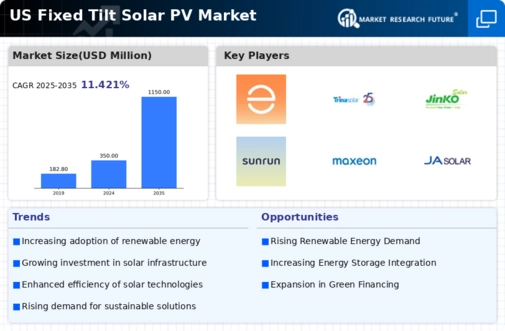The US Fixed Tilt Solar PV market is characterized by an increasingly dynamic competitive landscape, driven by advancements in solar technology, changes in regulatory frameworks, and escalating demand for renewable energy sources. As various players vie for market share, they leverage strategies focused on innovation, product differentiation, and competitive pricing in order to establish a foothold in this rapidly expanding sector. The landscape is marked by various factors including shifts in consumer preferences, technological advancements, and strategic collaborations that influence the positioning of key market players.
Moreover, as utility-scale projects gain traction alongside residential installations, competition has intensified not just in terms of pricing but also in the efficiency and reliability of solar solutions being offered.Enphase Energy has emerged as a prominent player in the US Fixed Tilt Solar PV market, primarily known for its innovative microinverter technology that enhances the efficiency and reliability of solar installations. The company has positioned itself strategically through a combination of high-quality product offerings and robust customer service, drawing in various stakeholders ranging from residential homeowners to commercial clients.
Enphase Energy’s microinverters are a critical strength, allowing customers to optimize energy generation and monitor system performance effectively.
Additionally, the company’s commitment to research and development ensures it remains at the forefront of technological advancements, positioning its products as reliable solutions in the competitive landscape of the US solar market.Trina Solar stands out as a significant competitor within the US Fixed Tilt Solar PV market, recognized for its wide-ranging portfolio of high-performance solar modules and comprehensive services. The company focuses on providing cutting-edge solar technologies, including bifacial modules, which enhance energy yield and efficiency for fixed tilt installations.
Trina Solar’s strong brand reputation is bolstered by its extensive manufacturing capabilities and commitment to quality control, allowing it to maintain a solid market presence. The company's strengths lie not only in its innovative product offerings but also in its strong distribution network and customer support services.
Trina Solar has actively pursued growth through strategic mergers and acquisitions, enabling it to expand its operational capabilities and enhance its market positioning within the American solar landscape. This commitment to expansion and innovation positions Trina Solar favorably in the competitive US Fixed Tilt Solar PV marketplace, as it continues to meet the evolving energy needs of various consumer segments.





















